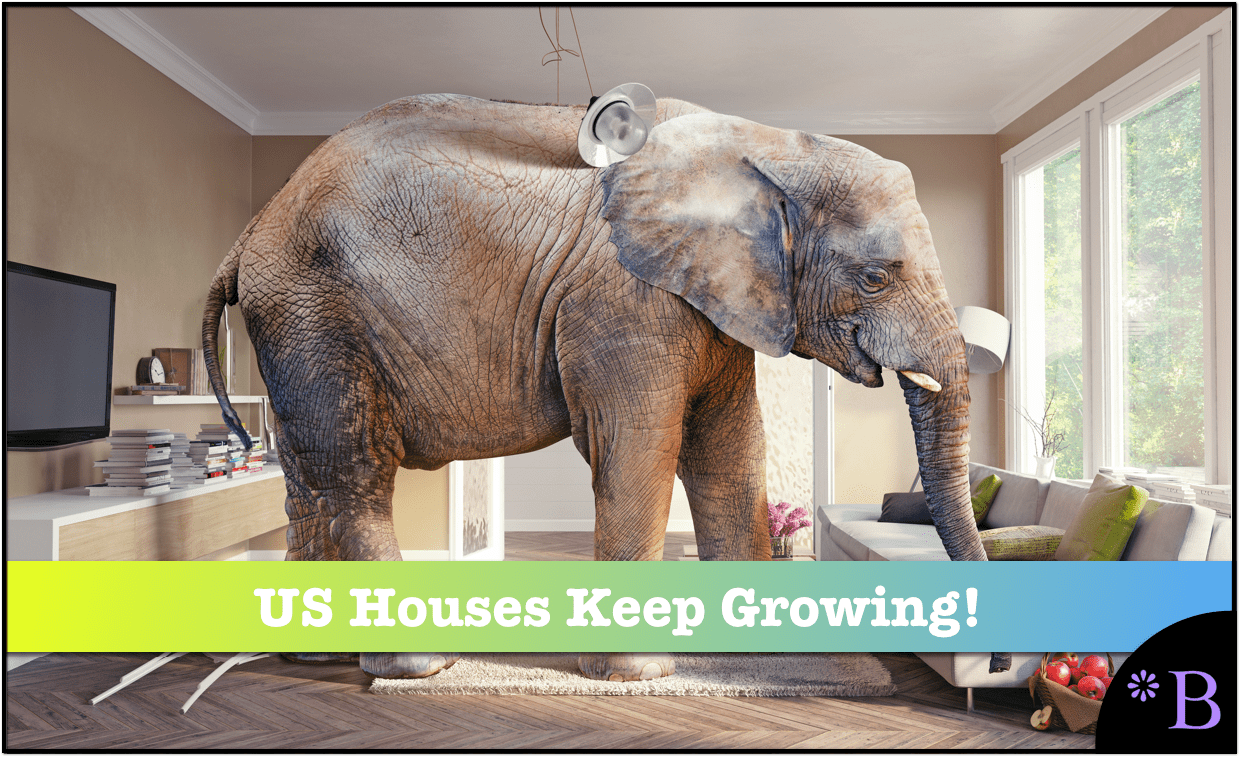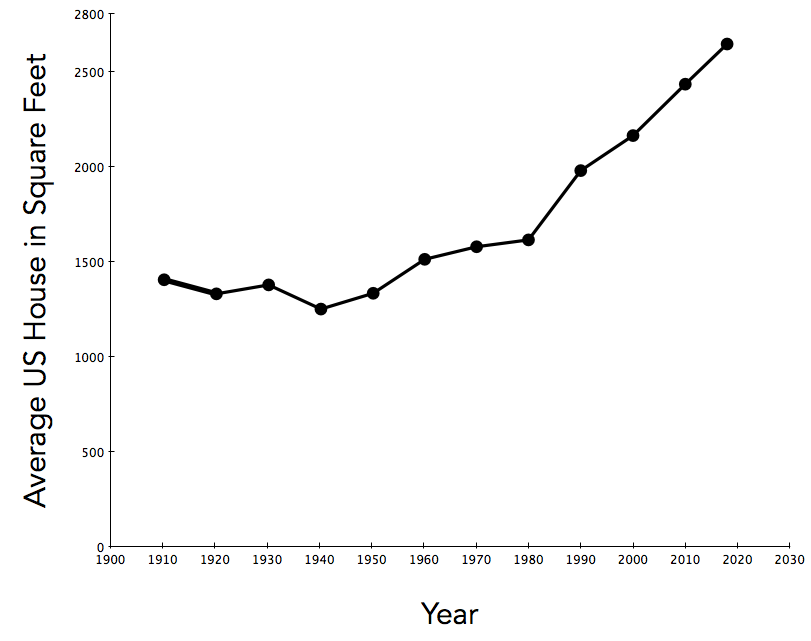What Does the Growth in the US House Square Foot Tell Us About Consumption?
Executive Summary
- The US has seen a steady and mostly undiscussed increase in the average size of houses.
- What does this mean for the change in US society and consumption?

Introduction
The US has greatly increased in conspicuous consumption particularly beginning in the 1980s. This has had an outcome in the average size of houses.
Consumption Patterns
This excellent documentary shows how the US developed into an increasing pattern of work and spend. And that much of the yearly purchases of Americans have more to do with meeting status needs than any actual human need.
The Yearly Size of US Houses

This chart was created with data from the website Property Shark. It shows the increase in the square foot of the average house in the US. Notice the inflection from 1980s onwards.
The Shrinking Number of People Per House
Furthermore, in 1910 there were on average 4.5 people in this house. By 2018 there are 2.4 people occupying a house that is roughly twice as large. This means that the average person consumed roughly 300 square feet of housing space in 1910, now consumes over 1000 square feet of housing space.
Larger Houses, with a Shrinking Labor Component as a Percentage of the Price of a House: The Rising Employment of Low Cost, Non-Union and Illegal Labor
Another area of housing changed around the 1980s, which is the increasing use of non-union, low cost and in many cases illegal labor.
This is expressed in the following quotation.
”It is estimated that 5% of the U.S. work force, and 14 – 25% of construction workers are illegal aliens. (It’s politically correct to call them undocumented workers, but let’s get real, they are undocumented because they are here illegally.)
Remember when most of our clothing was made in the U.S.? Manufacturers discovered they could find workers outside the country who would work for less. How about the automobile industry? Many cars purchased in the U.S. are either completely assembled outside the U.S., or parts are manufactured outside the U.S., because labor outside the country is cheaper.
In the construction industry (and other industries with a strong illegal work force, such as agriculture and janitorial services), it is impossible to send the work to other countries, so instead of exporting the work, we import the workers. Or rather, we look the other way when they come in the country.” – Markup and Profit
And the following:
“Construction in Los Angeles has shifted from a heavily unionized labor force that was two-thirds white to a largely non-union one that is 70% Latino and heavily immigrant.
At the same time, the job got less lucrative. American construction workers today make $5 an hour less than they did in the early 1970s, after adjusting for inflation.” – Los Angeles Times
This shows that the construction industry either did not become more productive or that any productivity benefits were not shared with workers — and most likely this is due to the extra supply of immigrant labor.
Interestingly, construction is a “hard job,” and one that at one time required a premium to entice people to do this type of work. That was the nature of the job before the influx of immigrants to construction, but now that is no longer the case as the following quotation explains.
In 1972, construction paid today’s equivalent of $32 an hour, almost $10 more than the average private-sector job. But real wages steadily declined for decades, erasing much of that gap.
Today slightly more than 1 in 10 construction workers are in a union, compared with 4 in 10 in the 1970s.” – Los Angeles Times
As with the consumption of electronic items and apparel items — which are now mostly made in Chinese sweatshops under near slavery conditions, home buyers don’t seem to much care about the declining labor standards and pay in the construction industry, as long as they can continue to buy larger houses.
Off the Books Storage
The increased size in houses actually underestimates the average amount of space taken up by each person in the US. This is because of the “off the books” storage called the personal storage industry. And most of the people that avail themselves of personal storage live in houses.
“67% of self storage renters live in single-family homes — only 27% live in apartments. Most of these renters live in single family homes which have a garage and 33% also have a basement in their home. [Source: SSA] They still need the extra room a storage unit provides.” – Self Storage
Conclusion
The growth in the size of US houses has increased unabated since 1940 but has really increased in the past four decades.
This is conspicuous consumption, and recent non-union immigrant and illegal immigrant labor have driven lower wages and for the labor component of houses to be smaller. Construction is now not seen as a desirable place to work and the industry has difficulty in attracting non-immigrant labor.
References
https://www.markupandprofit.com/blog/undocumented-illegal-workers-construction
https://theweek.com/articles/716105/want-happier-live-small-house
“What these spaces aren’t empty of is stuff. Just as work expands to fill the time allotted, our useless crap expands to fill the space we give it. Our houses are bigger because we need more space to store our junk, and our junk pile grows because, hey, there’s room for it in the garage. You don’t have to go full KonMari to recognize that this isn’t healthy, and it certainly doesn’t make life better or wallets fuller.
More space and more stuff also means more cleaning, repairs, and a heavier mental load of household chores. This is especially true for women, who continue to do more housework than men, even when they work outside the home or — appallingly — when sharing a home with an unemployed man. A bigger house means more to mow, more to vacuum, more to clean, ad naseum.”
https://www.latimes.com/projects/la-fi-construction-trump/
https://www.spectator.co.uk/2018/08/what-do-women-really-want-a-man-with-a-beautiful-house/
https://www.cbsnews.com/news/illegal-immigrants-us-jobs-economy-farm-workers-taxes/
*https://www.propertyshark.com/Real-Estate-Reports/2016/09/08/the-growth-of-urban-american-homes-in-the-last-100-years/